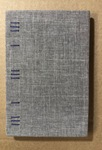
Hot House has at long last arrived here at Copacetic! The publisher, Fieldmouse Press, has produced a very nice, heavy-duty, oversize (9" x 11"), Smyth-sewn hardcover edition that runs 100 pages; in black & white, of course.
A notably multidisciplinary artist, John Hankiewicz is best known among Copacetic customers for his comics work, which features a labored, detailed pen & ink drawing style that has gradually evolved over his quarter century of comics making. His comics work is also especially notable for its highly successful translations of verbal/textual poetic principles such as meter, foot and rhyme into their visual/comics equivalents, as well as elements analogous to those of musical composition: various rhythms, particularly contrapuntal; the flow from tension to resolution that translates arrangements of musical notes/chords/progressions into arrangements of visual elements/objects/symbols, occasionally forefronted to such a degree as to leave the narrative elements (often obscurely) in the background.
He has created a wide range of comics work in a considerable variety of forms. Hot House is his first major work since Education, published by Fantagraphics Underground in 2017 – after being self-published a year or two earlier; so, it's been awhile. Hot House is in many respects his most formal work yet. While the superficial theme of the work may be taken to be that of a simple suburban domestic drama, within its 96 pages of “silent” (textless) comics, the diegesis becomes completely untethered from normative expectations, yet manages to keep the reading experience firmly anchored through its employment of a strictly uniform, four-panel grid.
In lieu of the story-based narrative arc typically found in works of this length, Hot House takes an entirely different tack. The work is propelled by a multileveled set of formal polyrhythms that together serve to represent the complex rhythm of domesticity and its deep roots in the unconscious.
This emerges in a play of visual associations between a variety of objects – carrying varying degrees of symbolic weight – within an ever shifting – and at times jarring – visual orientation of the interior and exterior domestic spaces, combined with a disjointed and constantly shifting temporal scale – often including split-second moments that would fail to be perceived in such a way by normal human perception – that, taken together, work to manifest an intricate interplay of memory, fantasy and dreams in the service of representing the inherently unstable – and deeply mysterious – nature of the domestic relations.
You can start to get an idea of what we're talking about by spending some time with this preview hosted by SOLRAD for the original crowdfunder that launched its release.
RECOMMENDED
BACK IN STOCK, FINALLY!





















